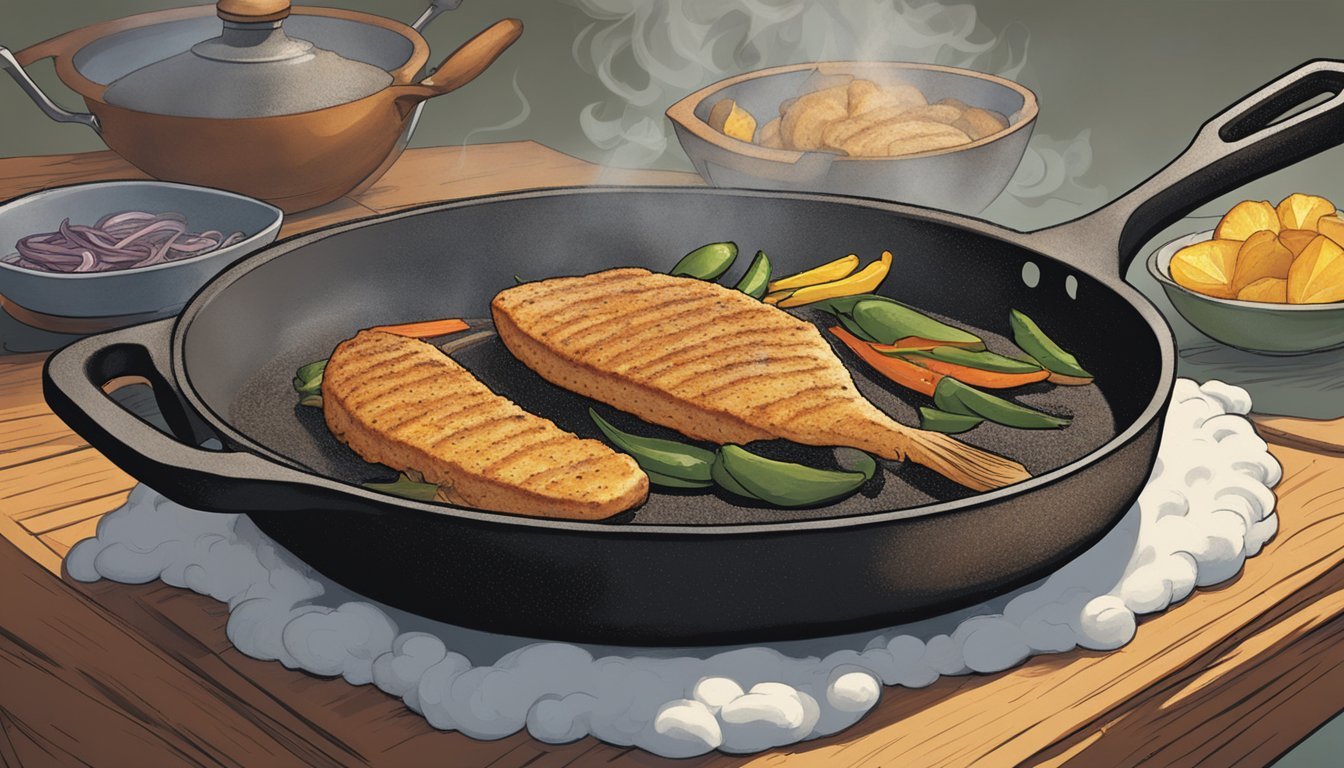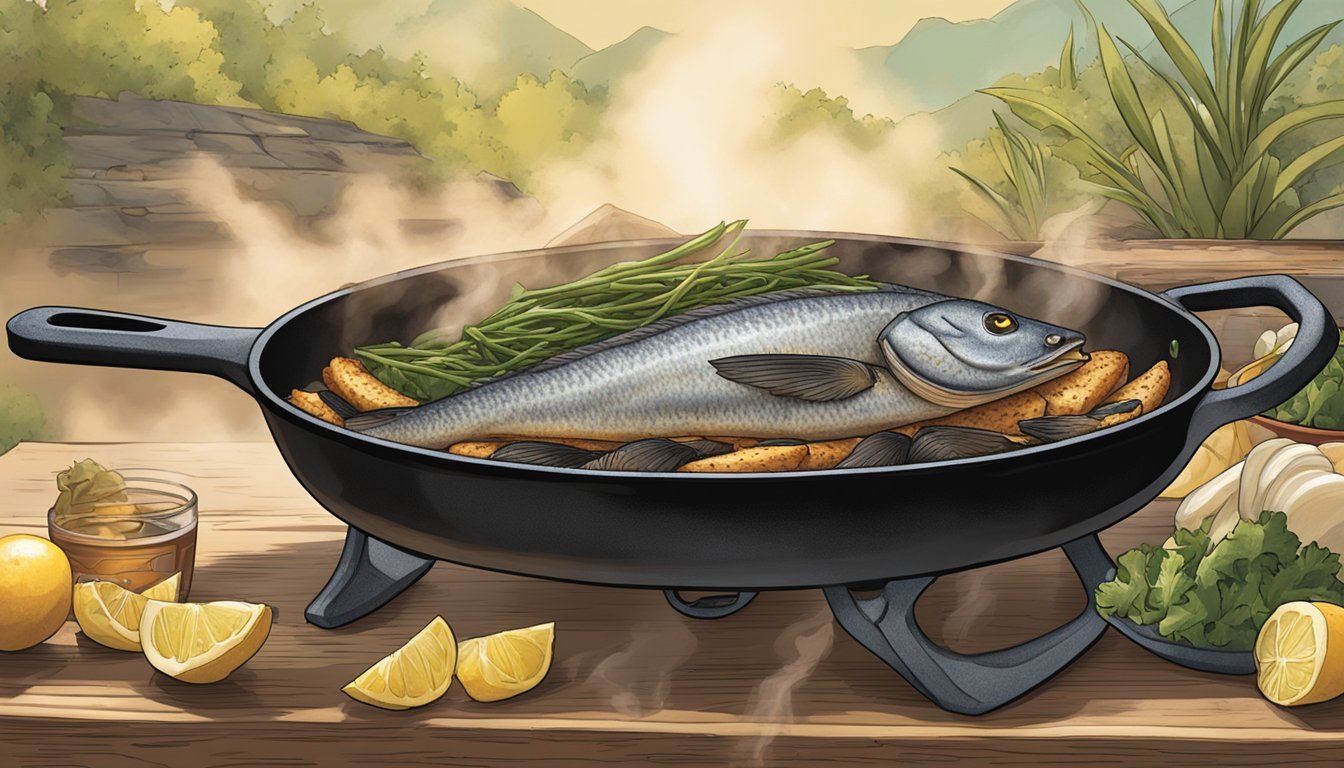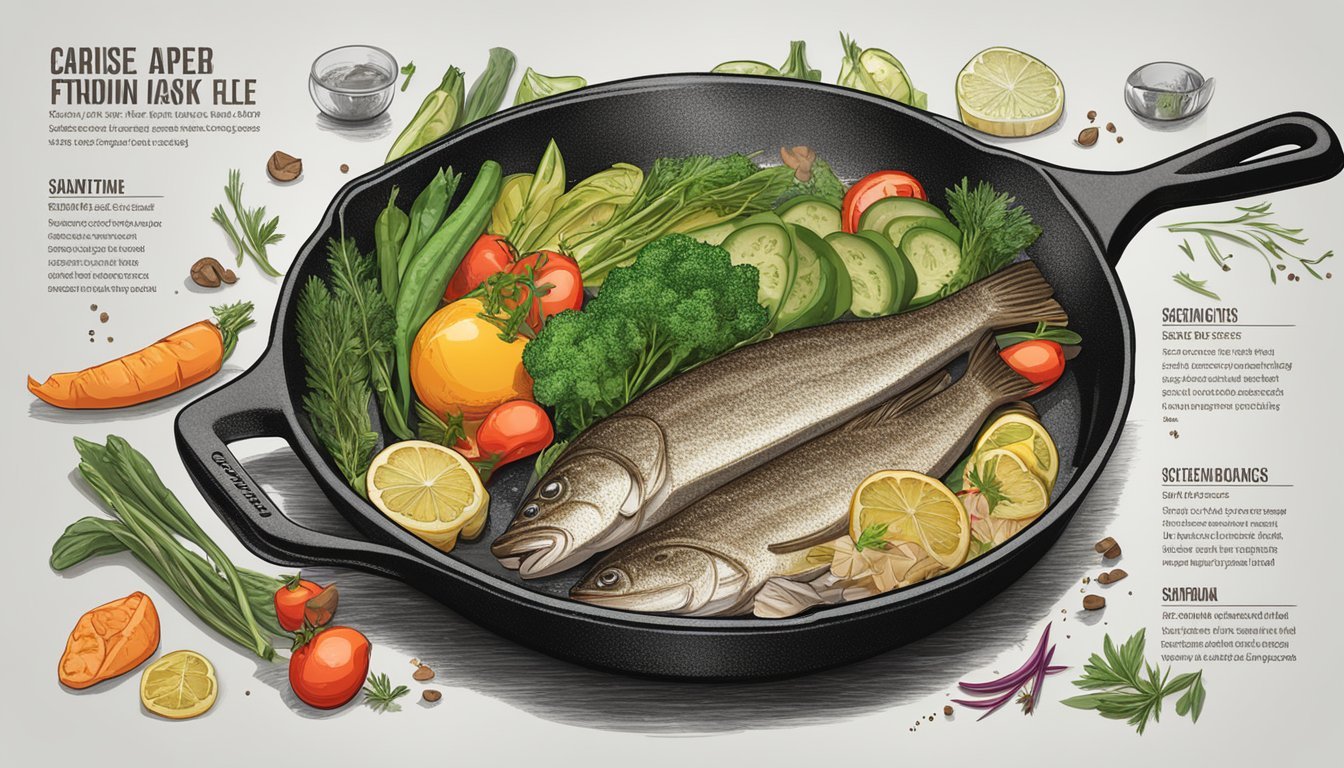How to Cook Texas-Style Blackened Catfish
A Savory Southern Classic Tutorial
Blackened catfish is a quintessential dish that echoes the bold flavors of Texas-style cooking. It's a simple yet impressive recipe, rooted deeply in the Southern culinary tradition, where the spice-rubbed fish undergoes a searing process that forms a characteristic dark crust, brimming with both heat and flavor. The essence of the dish lies in its spice mixture, often a vibrant blend of paprika, cayenne pepper, garlic powder, and other seasonings that give catfish its signature blackened crust.
In cooking blackened catfish, using a cast iron skillet is essential as it retains high heat and distributes it evenly, ensuring the fillets are perfectly cooked. The method is straightforward - the fish fillets, coated in a generous layer of spices, are cooked in a hot skillet with butter until the spices form a crust on the fish. The result is a mouthwatering entree with a smoky, spicy exterior that complements the mild, flaky interior of the catfish.
Cooking this dish at home can turn an ordinary meal into a Texan feast with minimal effort. It is important not to flip the fish too early to allow the crust to develop fully. This process, along with the use of the right amount of spice mix and heat, culminates in a blackened catfish that is as delicious to eat as it is simple to prepare.
Understanding Catfish
As one ventures into the realm of Southern cooking, it becomes crucial to comprehend the varieties of catfish available and the factors to consider when selecting catfish for a Texas-style meal.
Types of Catfish
North America is home to a diverse group of catfish species, each with its own unique qualities. Among the most commonly known are the Channel catfish and the Blue catfish. Channel catfish are renowned for their excellent flavor and texture, while Blue catfish are typically larger and can provide a heartier serving. A more local variety to Texas waters, the Flathead catfish, is also a popular choice among Southern cooking enthusiasts. It’s important to note that not all catfish are equal when it comes to flavor and culinary potential.
Choosing the Right Catfish
In terms of selecting the right catfish for Texas-style dishes, one should look for firmness of flesh and a clean appearance. The majority of catfish found in markets will be farm-raised which is often a guarantee of regulated quality and sustainability. Farm-raised catfish offer consistent flavor and are generally available year-round. When choosing catfish, one can rely on the fact that farmed catfish are regulated and fed a controlled diet, which can contribute to the milder taste and less muddy flavor some associates with wild catfish. It's essential for the catfish to be fresh to ensure the best outcome for your blackened dish.
Essential Ingredients
The success of Texas-style blackened catfish hinges on its robust seasoning and the use of fats to create that iconic crust. Selecting the right ingredients ensures the fish delivers on both flavor and texture.
Spices for the Blackened Seasoning
A dynamic blend of spices is crucial for authentic blackened seasoning. The base typically comprises:
Salt to enhance the overall flavor profile.
Black Pepper for a piquant sharpness that is essential to the heat of the dish.
Paprika contributes a sweet-peppery taste and adds a rich color.
Cayenne Pepper increases the heat level, providing the characteristic spiciness.
An ideal seasoning blend for one pound of catfish fillets might look like:
Ingredient Quantity Salt 1 tsp Black Pepper 1 tsp Paprika 2 tsp Cayenne Pepper ½ tsp
These spices, when blackened, lead to a complex and deeply flavorful crust that is signature to the dish.
The Role of Fats in Cooking
Fats are central to the cooking process, providing both flavor and the means for the spices to adhere to the catfish. Here are the fats typically used:
Butter is melted and brushed onto the catfish before seasoning. It adds a rich flavor and helps the spices to stick to the fish.
Oil, such as vegetable or canola, is sometimes used in the skillet to prevent sticking and add another layer of flavor.
For cooking, a chef might consider:
1/4 cup of butter, melted, for coating the catfish fillets.
A few tablespoons of oil in the skillet to create a non-stick surface and contribute to the blackening process.
Preparing Catfish Filets
The success of a Texas-style blackened catfish dish depends on properly prepared filets. This section covers the initial cleaning and filleting process as well as the steps to ready the catfish for blackening.
Cleaning and Filleting
Once the catfish is caught or purchased, one must ensure it is cleaned thoroughly. To begin, they should rinse the catfish under cold water to remove any debris. Filleting involves cutting away the sides of the fish to separate the flesh from the bone. Using a sharp fillet knife, they make a slit behind the gills and work down to the tail, staying close to the spine. After the fillets are separated, the next step is to check for any remaining bones and remove them.
Prepping for Blackening
Before the catfish fillets are ready for blackening, they must be properly prepped. To start, they should drain any excess liquid from the fillets and pat them dry with paper towels to remove moisture. This helps the blackening spices adhere better. If they choose to use a marinade to tenderize and flavor the fillets, they could soak them in a mixture of milk, buttermilk, or whole milk. Sometimes, an egg is beaten into the milk to help the coating of blackening spices stick. The fillets are submerged in the chosen liquid and then allowed to sit for a short period before seasoning and cooking.
Making the Blackened Seasoning
The foundation of an excellent Texas-style blackened catfish is its seasoning. The right blend of spices creates a crust that is flavorful and spicy, encapsulating the heritage of Cajun cuisine.
Mixing the Spices
To begin, one must choose high-quality spices for maximum flavor. The essential spices for the seasoning include:
Paprika (2 tablespoons): Provides a sweet and smoky base.
Garlic Powder (1 teaspoon): Adds a savory and aromatic note.
Onion Powder (1 teaspoon): Gives a pungent kick.
Dried Thyme (1 teaspoon): Lends the dish an earthy undertone.
Dried Oregano (1 teaspoon): Offers a slight bitterness and warm flavor.
Cayenne Pepper (1 teaspoon): Responsible for the heat in the blackened crust.
Black Pepper (1 teaspoon): Adds a sharp and woody depth.
Kosher Salt (1 tablespoon): Enhances the natural flavors of the catfish and the spices.
Sugar (1/2 teaspoon, optional): Can help in caramelization and balance the heat.
For a cohesive blend, one should thoroughly mix these ingredients in a bowl until combined. Store any extra seasoning in an airtight container to maintain its potency.
Applying the Seasoning to Catfish
When preparing the catfish, it's crucial to ensure that the fillets are dry by patting them with a paper towel. To apply the seasoning:
Generously coat the catfish fillets: This ensures a robust flavor and the signature blackened crust.
Press firmly to adhere: The seasoning should evenly cover the catfish, pressing eliminates any loose spots that could result in uneven cooking.
For best results, let the seasoned catfish fillets sit for a few minutes to allow the flavors to marry before cooking in a hot skillet. This ensures that every bite of the Texas-style blackened catfish is enjoyable.
Cooking Techniques
Preparing Texas-style blackened catfish requires the use of specific cookware and an understanding of heat management to ensure a perfectly seasoned and cooked fillet.
Using the Right Skillet
A large cast-iron skillet is essential for blackening catfish as it retains heat well and distributes it evenly. Cast iron creates a superior crust on the fish, which is a hallmark of the blackening process. If one doesn't have a cast-iron skillet, a heavy aluminum skillet can be an alternative, but the former is preferred for its heat retention properties.
Mastering the Heat
The catfish should be cooked over medium-high heat to achieve the characteristic blackened crust without burning the spices. The skillet must be preheated until it's very hot before adding the fish. A combination of oil and butter in the skillet can help achieve a crispy exterior while keeping the interior tender and opaque. To test the readiness of the skillet, a drop of water should sizzle and evaporate immediately upon contact.
Serving and Pairings
To elevate the flavors of Texas-style blackened catfish, the right accompaniments can make all the difference. From sides to a perfect sauce, pairing enhances the overall dining experience.
Choosing Accompaniments
The rich and spicy flavor profile of blackened catfish pairs well with a variety of side dishes. One should consider balance, opting for sides that can complement the bold taste without competing with it. Collard greens and coleslaw are traditional options that provide a refreshing contrast. Here's a succinct list to guide the selection:
Vegetables: Collard Greens — A southern staple, their slightly bitter taste balances the spice.
Starches: Hush Puppies — These provide a sweet and crispy counter.
Salads: Coleslaw — Its creaminess and crunch offer a refreshing bite.
Sauces: Tartar Sauce or Lemon Wedges — Both cut through the spice with acidity.
Beverages: Beer — A cold lager complements the catfish without overwhelming the palate.
Presentation Tips
When presenting Texas-style blackened catfish, attention to detail can turn a simple dish into an impressive meal. It is best served hot, straight from the skillet onto a warm plate. Drape the catfish with Tartar Sauce or garnish with Lemon Wedges to add a zesty accent. Below are tips for an inviting presentation:
Plate Design: Center the catfish on the plate, providing ample room for sides.
Color Contrast: Alternate the colors with greens and the golden brown of hush puppies to create visual appeal.
Sauces: Serve sauces like tartar in small ramekins or artfully drizzled over the catfish.
Freshness: A last minute squeeze of a lemon wedge over the fillet can add a bright note right before serving.
Additional Tips and Variations
When preparing Texas-style blackened catfish, one can enhance the dish by adjusting the level of spiciness and exploring different cooking methods to suit personal preferences and available kitchen equipment.
Adjusting Spiciness
To control the spiciness of the blackened catfish, one should modify the spice mixture. For a milder flavor, reduce the amount of cayenne pepper or replace it with paprika, which offers a sweeter tone without the heat. Conversely, to increase the dish's spiciness, add extra cayenne pepper or incorporate diced jalapeños into the spice rub. A flaky and savory taste is achieved by balancing these spices with herbs like thyme and oregano.
Mild Version: Use 1 tablespoon paprika, 1 teaspoon garlic powder.
Spicy Version: Use 1 tablespoon cayenne pepper, 1 teaspoon black pepper.
Alternative Cooking Methods
While frying in a cast iron skillet is traditional, one can use alternative methods such as a pellet grill for a smoky flavor or bake in an oven for a less oily preparation.
Pellet Grill: Preheat to high heat and cook the seasoned catfish on the grill grates, closing the lid to infuse smoky flavors. (What wine goes well with smoky flavors?) This method can give the catfish a subtly crispy texture.
Oven Baking: Preheat the oven to 425°F. Place seasoned fillets on a baking sheet. Bake for about 15 minutes or until the fish is flaky and the edges appear slightly crispy.
For both methods, brush the catfish with olive oil or unsalted butter before cooking to ensure moisture is retained and to assist in developing a savory crust.
Nutritional Information
Texas-style blackened catfish is a popular dish known for its bold flavors and seasoning. When it comes to nutritional value, catfish is a source of several important nutrients and can be a healthy addition to one's diet when prepared properly.
Caloric Content: A typical serving of blackened catfish, which is roughly 4 ounces (113 grams), contains approximately 200 calories. The exact number can vary based on the size of the fillet and the amount of butter or oil used in cooking.
Macronutrients:
Protein: Catfish is high in protein, providing about 20 grams per serving, which is crucial for muscle repair and growth.
Fat: The dish can contain a moderate amount of fat, around 10 to 15 grams, largely due to the cooking method. However, unsaturated fats like olive oil can be used as a healthier option.
Carbohydrates: Catfish itself is low in carbs, but the blackening seasoning may add a small amount, depending on the ingredients used.
Vitamins and Minerals:
Vitamin D: Providing a good source of vitamin D, important for bone health.
B Vitamins: Including B12, niacin, and B6, which play a role in energy metabolism and neurological health.
Selenium and Phosphorus: Both minerals are found in catfish, supporting various bodily functions including antioxidant protection and bone health.
Considerations for a Healthy Diet:
Sodium levels can be high in blackened catfish due to the spices used. Those watching their sodium intake should consider adjusting the seasoning blend.
The cooking method, which typically involves high heat and minimal added fat, helps retain the nutritional benefits of the fish while adding a rich, smoky flavor.
By choosing healthy oils for blackening and being mindful of portion sizes, Louisiana-style blackened catfish can be a delicious and nutritious component of a balanced diet.
Frequently Asked Questions
This section addresses common inquiries regarding the storage of leftover blackened catfish and the health benefits of incorporating catfish into one's diet.
Storing Leftovers
When it comes to storing leftover blackened catfish, it's important to ensure food safety and maintain the quality of the fish. Leftovers should be stored in an airtight container and refrigerated within two hours of cooking to prevent bacterial growth. They can generally be kept for up to three days. For optimal freshness, here is a brief guideline:
Refrigerate promptly: Store in an airtight container at 40°F (4°C) or colder.
Reheat thoroughly: When ready to eat, reheat the catfish to at least 165°F (74°C).
Health Benefits of Catfish
Catfish is not only a delicious ingredient in various recipes but also offers numerous health benefits. It is a low-fat source of protein and is packed with essential vitamins and minerals. Below is a summary of its benefits:
Nutrient-rich: High in Vitamin D and B12.
Omega-3 fatty acids: Contains heart-healthy fats.
In summary, catfish can be a beneficial addition to one's diet when prepared and stored correctly.





